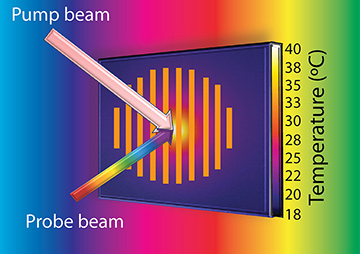 A schematic representation of a thermo-plasmonic-activated reverse-mode diffraction grating. [Enlarge figure]
A schematic representation of a thermo-plasmonic-activated reverse-mode diffraction grating. [Enlarge figure]
Thermo-plasmonics is an interdisciplinary research field dealing with the generation of nanoscale heating through the interaction between a suitable, resonant light source and noble-metallic nanoparticles (NPs). In recent years, thermo-plasmonics has been successfully employed in research fields ranging from electronics1 to medicine.2
We have extended the utilization of thermo-plasmonics in optics by realizing a novel generation of light-controlled optical components. This achievement has been enabled through bridging the photothermal properties of gold nanoparticles and the thermo-sensitivity of liquid crystalline materials.3,4
As a proof of concept, we used the thermo-plasmonic heating of gold nanorods to activate and deactivate the diffractive properties of a reverse-mode diffraction grating made of nematic liquid crystal (NLC) and a polymerizable liquid crystal (PLC). The grating is completely “hidden” and appears as a transparent optical window in the off state because of the initial refractive-index match between the PLC-rich and NLC-rich regions. Photo-exciting the NP-containing structure with a suitable light source (λ = 808 nm) causes thermo-plasmonic heating, inducing a refractive-index mismatch between the PLC and NLC and resulting in a highly efficient diffractive structure.
Additionally, we showed that the same structure can realize a variable waveplate, thus enabling a new method for detecting and predicting photoinduced temperature variations as well as for controlling the phase retardation of a polarized light beam. The realized optical components do not require optical power in the diffraction off state thanks to the reverse-mode working principle.
Our findings represent the first demonstration of reconfigurable thermo-plasmonic-activated optical components. These results4 open a new scenario in light-controllable photonics—one that could prove particularly important for polymers that do not allow electric-field control. What’s more, NPs with exotic shapes such as triangle, cube and hexagon could be useful in developing on-chip photothermal sensors, thus adding a new level of flexibility to existing photonic devices. We are pushing this versatility even further through the realization of a new generation of biomedical thermal sensors by exploiting the interplay between thermo-plasmonics and water-based liquid crystal thermometry.
This research was supported by the Air Force Office of Scientific Research (AFOSR), Air Force Research Laboratory (AFRL), U.S. Air Force, under grant FA9550-18-1-0038 (P. I. L. De Sio, EOARD 2017-2020) and the Materials and Manufacturing Directorate, AFRL.
Researchers
Luciano De Sio, Sapienza University of Rome, Latina, Italy, and CNR-NANOTEC, Arcavacata di Rende, Italy
Nelson Tabiryan, Beam Engineering for Advanced Measurements Company, Orlando, Fla., USA
Timothy J. Bunning, Air Force Research Laboratory, Wright-Patterson Air Force Base, Ohio, USA
References
1. L. De Sio et al. Prog. Quantum Electron. 41, 23 (2015).
2. R. Bardhan et al. Accts. Chem. Res. 44, 936 (2011).
3. L. De Sio et al. ACS Appl. Mater. Interf. 10, 13107 (2018).
4. L. De Sio et al. ACS Appl. Nano Mater. 2, 3315 (2019).
